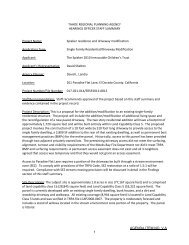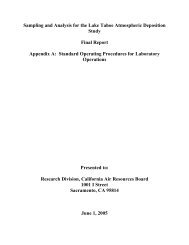FEIS - Tahoe Regional Planning Agency
FEIS - Tahoe Regional Planning Agency
FEIS - Tahoe Regional Planning Agency
Create successful ePaper yourself
Turn your PDF publications into a flip-book with our unique Google optimized e-Paper software.
RESPONSE TO COMMENTS ON THE DEIS<br />
B o u l d e r B a y C o m m u n i t y E n h a n c e m e n t P r o g r a m P r o j e c t E I S<br />
o Stormwater runoff from the project area occurs in 6-7 days under E20 conditions<br />
and 2-6 days for C20 conditions and does not occur for C100 conditions.<br />
o Total sediment, fine sediment and nutrient loads are presented in Tables 2 and 3<br />
of Appendix AB for a variety of wet and dry water year conditions. Field<br />
monitoring of runoff from disturb soils indicates FSP load is 50 percent of TSS<br />
loads from granitic soils and JBR data (DEIS Appendix P) reported levels as high<br />
as 90%. For modeling and reporting purposes for the supplemental analysis, FSP<br />
of less than 20 microns are reported as 60 to 90 percent of the TSS load. The<br />
FSP load of less than 20 microns includes FSP loads of less than 16 microns. For<br />
E20, C20 and C100, a dry year is forecasted to contribute 4,374 lbs, 1,714 lbs<br />
and 134 lbs of FSP, respectively.<br />
o The C100 SWMP will reduce total sediment loading by 97 to 100 percent as<br />
compared to E20 SWMP.<br />
• Wet Water Years/Worst-Case Scenarios (1994-1995 and 2005-2006) –<br />
o E20 conditions result in possible discharge of approximately 17,000 to 32,000 lbs<br />
of total sediment (note that the DEIS reports approximately 34,000 lbs based on<br />
grab sample extrapolations) and 14,000 to 29,000 lbs of FSP leaving the project<br />
area.<br />
o Implementation of C20 reduces the landing compared to E20 by roughly 23 to 43<br />
percent to ranges of 13,000 to 19,000 lbs of total sediment and 8,000 to 18,000<br />
lbs of FSP.<br />
o Implementation of C100 reduces loading compared to E20 by roughly 88 to 92<br />
percent to ranges of 1,400 to 3,900 lbs total sediment and 800 to 3,500 lbs of<br />
FSP.<br />
o Stormwater runoff from the project area occurs on 34 to 42 days under E20<br />
conditions, 16 to 27 days for C20 conditions and 3 to 5 days for C100 conditions.<br />
o Stormwater runoff from the project area occurs under C100 conditions only for a<br />
substantial rain-on-snow event of 5.37 inches (New Year’s Eve 2005) and after<br />
sequential 2 inch rain-on snow events (January 2005).<br />
o Data shows that in wetter years, which represent worst-case scenarios, total<br />
sediment output from C100 SWMP is over an order of magnitude (10X) less than<br />
those produced by E20.<br />
Please see Appendix AB for supplemental analysis for additional quantification of surface water<br />
quality benefits, notably predicted load reductions for total sediment, fine sediment and nutrients.<br />
The analyses for Impacts HYDRO-1 and HYDRO-3 are presented in the format determined and<br />
reviewed by TRPA Staff. The supplemental water quality analysis does not change the analysis<br />
for HYDRO-1 and HYDRO-3 but provides additional quantified results that support the<br />
conclusions that potential impacts discussed in HYDRO-1 and HYDRO-3 are reduced to a level<br />
of less than significant.<br />
SEPTEMBER 8 , 2010 HAUGE BRUECK ASSOCIATES PAGE 8- 15






